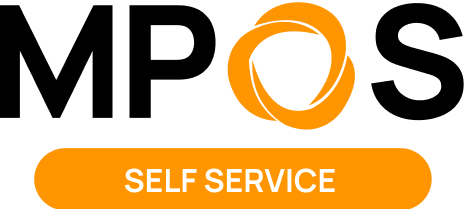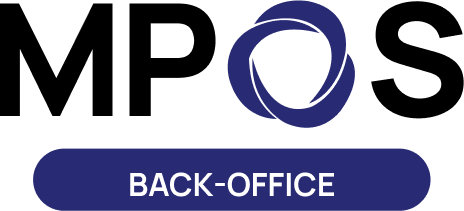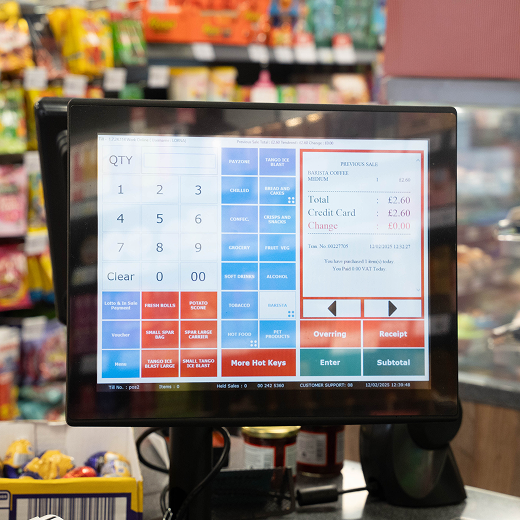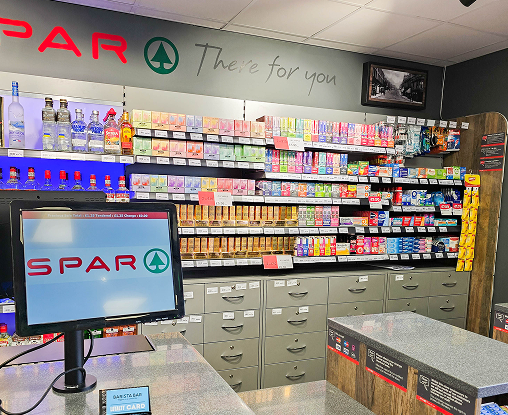In today’s digital-first retail world, even the smallest square can make a big impact, yes, we’re talking about QR codes. Quick Response (QR) codes are no longer just a pandemic-era solution for contactless menus, they’re now essential tools for enhancing customer experience, streamlining operations, and driving sales in UK convenience stores.
So, if you’re running a corner shop, local newsagent, or small-scale supermarket, here’s your complete guide to getting, using, and maximising QR codes for your business.
What Is a QR Code, and Why Should Convenience Stores Care?
A QR code is a scannable image made up of black and white squares. When customers scan it with their smartphones, they’re instantly directed to online content: websites, apps, payment portals, menus, feedback forms, you name it.
Why It Matters for Convenience Stores:
- Fast & contactless transactions
- Promote special offers instantly
- Simplify loyalty sign-ups
- Display allergen or product info
- Link to social media or online stores
In short, QR codes save time, reduce queues, and make your store feel tech-savvy without requiring big investments.
Why QR Codes Matter for UK Convenience Stores
QR codes may look simple, but their impact on retail, especially convenience stores, is significant. They’re no longer a trend, they’re a customer expectation. Here’s why.
A. Rapid Growth and Usage Trends in the UK
The UK is one of the leading countries in Europe when it comes to QR code adoption. Here’s a breakdown of key statistics:
- Around 13% of all QR code users in Europe are based in the UK, which is higher than the global average of about 8%.
- More than 86% of smartphone users in the UK and Europe have scanned a QR code at least once.
- Around 36% of those users scan at least one QR code every week.
- 91% of UK smartphone users have scanned a QR code at some point.
This shows that UK consumers are highly familiar with QR codes. From scanning restaurant menus to accessing payment options or product details, customers are now actively looking for QR codes wherever they shop.
What this means for your store:
Customers already know how to use QR codes. You don’t have to teach them, you just have to give them something worth scanning.
B. In-Store Retail Behaviour and QR Impact
QR code usage within retail environments has grown fast, and convenience stores are perfectly placed to benefit.
- QR code use in stores jumped by 40% globally in the last year, thanks to trends like contactless shopping and digital coupons.
- 64% of in-store shoppers have scanned a QR code to get product information, discounts, or reviews.
- Among these, 71% of men and 58% of women say they have used a QR code while shopping.
How this helps your store:
- Shoppers want quick access to information without asking for help or waiting in queues.
- QR codes give you a digital tool right on your shelves or checkout counters.
- Especially in small stores with limited space, QR codes help offer more value without taking up physical room.
C. A Smart Tool for Independent Retailers
While big-name supermarkets have started integrating QR technology into their shelf labels and loyalty apps, independent convenience stores don’t need to be left behind.
- Free or low-cost QR code generators make it easy to get started.
- Scanning works directly from any smartphone camera, with no need to download apps.
- QR codes can help boost foot traffic, drive repeat visits, and improve the customer experience in a cost-effective way.
A well-designed and well-placed QR code on a shelf, product label, or checkout counter can increase customer interaction significantly. Whether it links to a digital coupon, a feedback form, or nutritional info, it gives shoppers something useful, and makes your store look modern and efficient.
Key Use Cases for Convenience Stores
How to Get a QR Code for Your Business (Step-by-Step)
Step 1: Decide the Purpose of the QR Code
Before generating a QR code, ask: What do I want customers to do when they scan it?
Some common QR code use cases in UK convenience stores include:
- Mobile Payments: Link to PayPal, Apple Pay, or MPOS-enabled checkout.
- Promotions & Discounts: Link to weekly deals or digital flyers.
- Feedback Forms: Collect customer feedback via Google Forms or SurveyMonkey.
- Loyalty Programs: Link to a signup page or app.
- Product Details: Provide information on allergens, ingredients, or sourcing.
- Social Media Profiles: Increase followers and engagement.
Pro tip: Each use case may require a separate QR code.
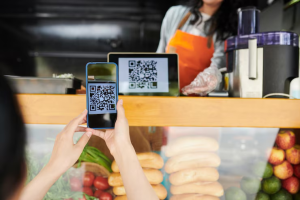
Step 2: Choose a QR Code Generator
There are tons of free and paid QR code generators online. For most convenience store needs, the free versions are good enough, but paid options offer more tracking, editing, and branding capabilities.
Recommended Free Generators:
- QR Code Generator
- GoQR.me
- Beaconstac (free tier available)
For Advanced/Branded Codes:
- Flowcode
- Scanova
- QR Tiger
Look for features like:
- Static vs Dynamic QR Codes
- Logo customisation
- Editable links
- Scan analytics
Step 3: Enter Your Content or Link
Just paste the URL or content you want the code to direct to. This can be:
- A website
- A PDF file (menu, brochure, receipt)
- A contact card
- A payment link
- A WhatsApp number
For example:
- www.yourstore.co.uk/offers
- Paypal.me/YourConvenienceStore
- Link to your Just Eat or Deliveroo profile
Bonus tip: Always test the link before generating and printing.
Step 4: Customise Your QR Code
Branding matters. Make your QR code reflect your store’s identity. Many generators let you:
- Add your store logo
- Change the colour to match your brand
- Adjust shape and corners
But keep it high-contrast and scannable, avoid pale colours or blurry patterns.
Step 5: Download & Print
Download your QR code in high-resolution (PNG, SVG, or PDF). Then print it on:
- Posters
- Price tags
- Storefront windows
- Receipts
- Fridge doors
- Checkout counters
Make sure it’s visible, clear, and labelled with a call-to-action like:
“Scan for this week’s deals”
“Tap to pay”
“Leave a review”
Static vs Dynamic QR Codes – What’s the Difference?
| Type | Best For | Can You Edit It Later? | Tracking? |
| Static | Permanent links (e.g., menu) | No | No |
| Dynamic | Time-sensitive content | Yes | Yes |
For seasonal deals or trackable campaigns, always go for dynamic QR codes.
Popular Use Cases for Convenience Stores in the UK
Let’s break it down even further with real-world examples:
1. Product Info
Place QR codes on shelves near specialty items like gluten-free products or imported goods. Link to ingredient lists or allergen info.
2. Digital Payments
Skip the card reader. Generate a QR code that links directly to your store’s PayPal, SumUp, or Stripe page.
3. Loyalty Programs
Encourage customers to join your loyalty scheme through a QR code. Reward repeat shoppers digitally!
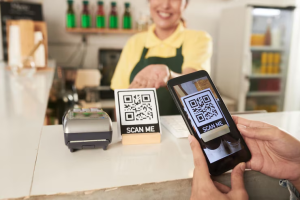
4. Promotions & Events
Got a flash sale or new product? Print a QR code that links to your promotional flyer or event details.
5. Customer Feedback
Place a QR code near the till that links to a short Google Form. Offer a small reward (like £1 off) for completing it.
6. Social Media Growth
Want more Insta or Facebook followers? Add QR codes that link directly to your social media pages.
QR Code Best Practices for Store Owners
- Add a call-to-action (“Scan to Save”, “Scan to Pay”)
- Place at eye-level or till-point
- Test on multiple devices (iPhone, Android)
- Keep URLs short and simple
- Use dynamic codes for flexibility
- Don’t shrink them too much, minimum 2cm x 2cm
- Avoid placing on reflective surfaces
Is There a Cost to Creating QR Codes?
Creating basic static QR codes is free.
But if you want:
- Analytics (how many people scanned)
- Editable links
- Brand design
- Expiry dates
…then you may want to consider a monthly plan from providers like:
- QR Tiger
- Flowcode
- Beaconstac
(Prices range from £4–£15/month)
Legal Considerations in the UK
While QR codes themselves are not regulated, data protection laws apply if you’re collecting customer data through forms or payment portals.
Make sure to:
- Use secure links (HTTPS)
- Mention how data will be used in feedback or loyalty forms
- Comply with GDPR when storing or processing customer info
How QR Codes and POS Systems Work Together in Convenience Stores
QR codes aren’t just about promotions and websites. In modern retail, they’re deeply integrated into POS systems, enabling faster transactions, seamless payments, better data collection, and smarter inventory management.
Let’s break it down:
1. QR Codes for Payments via POS Systems
Modern POS systems in the UK — especially cloud-based or tablet POS systems — now come with built-in support for QR code payments. This means:
- Customers can scan a QR code at the counter to instantly pay using Apple Pay, Google Pay, PayPal, or bank apps.
- No need for card insertion or physical contact.
- These QR codes can be:
- Dynamic: Generated at the POS for each transaction.
- Static: Linked to a fixed store wallet or bank account.
Benefits:
- Speeds up checkout queues (crucial for busy corner shops).
- Reduces card machine dependency and transaction fees.
- Offers contactless convenience — now a customer expectation post-COVID.
2. QR Codes for Digital Receipts and Customer Engagement
Advanced POS systems can generate a QR code on the printed receipt or screen. When customers scan it, they can:
- View or download their digital receipt
- Leave instant feedback or ratings
- Join your loyalty program
- Get special coupons or offers for their next visit
Why it matters:
This reduces paper waste, builds customer databases, and turns a quick sale into a long-term customer relationship.
3. QR Codes for Inventory Management via POS
POS systems with inventory tracking features can link QR codes to products for:
- Quick stock checks by scanning the code
- Real-time tracking of expiry dates or batch numbers
- Easier restocking and reordering
Some stores even use QR labels on shelves that connect to:
- Nutritional info
- Manufacturer certifications
- Smart price updates (when connected with ESLs or integrated apps)
4. Creating QR Codes Directly from POS Dashboards
Modern POS systems (like Square, Vend, Lightspeed, Shopify POS, or MPOS solutions) allow you to generate QR codes right from your backend:
You can create QR codes that:
- Link to your store’s website or online catalogue
- Take users to a “click and collect” order page
- Share custom offers via receipts, shelf stickers, or posters
5. Better Customer Insights with QR-Linked POS Data
If a customer scans a QR code to pay, download a receipt, or redeem an offer, your POS system can link that action to a transaction. This provides:
- Data on which products and offers are working
- Repeat customer tracking
- Insights into customer behaviour and buying trends
All this without needing to manually collect or match any information.
| QR Code Use Case | Powered by POS Features |
| Contactless Payments | QR codes generated at checkout |
| Loyalty Sign-ups | QR on receipts or via on-screen prompts |
| Promotions & Coupons | Tracked and distributed via POS |
| Digital Receipts | QR code link sent or printed |
| Product Information | Scannable shelf or product tags |
| Inventory Scanning | QR-linked item tracking |
If you want to use QR codes smartly, start with your POS system. It’s the central hub where transactions, inventory, promotions, and customer engagement come together, and QR codes are the bridge that connects all these elements with your customer’s smartphone.
Would you like a comparison of POS systems that offer QR code integration in the UK? I can create that too.
Quick Checklist for Busy Store Owners
- Set one objective per QR code (~focus increases conversions)
- Use dynamic codes for flexibility and tracking
- Design clearly with logos and high contrast
- Print at visible size (≥40 mm or 2 cm)
- Place near decision points—checkout, shelves, windows
- Include enticing CTA (“Scan for 10p off today!”)
- Monitor analytics monthly and tweak content
- Stay GDPR-compliant with data collection
- Prepare for ‘smart QR’ labels – watch Tesco/Ocado trials
Conclusion: Small Code, Big Results
QR codes are no longer optional, they’re part of the toolkit for running a smart, modern, customer-focused convenience store in the UK.
Whether you want to boost engagement, speed up service, or improve marketing, getting and using a QR code is quick, low-cost, and incredibly effective.
Start small. Test different QR placements. Track what works. And watch your store go from traditional to next-level digital, one scan at a time.

